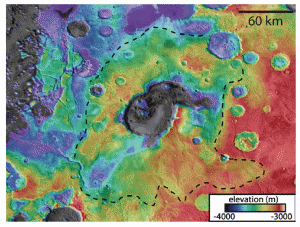Arabia is one of the largest and oldest regions of Mars. Among its varied rocks are widespread deposits of soft and easily eroded ones which may have a volcanic origin. However, Arabia has no obvious volcanic vents or sources. So are its volcanos so old they have been eroded into invisibility — or does Arabian volcanism look different from more familiar Martian volcanic styles?

THIS EDEN WAS NO GARDEN. Superficially, Eden Patera resembles an impact crater, but it lacks characteristic impact features such as an ejecta blanket, central peak, and raised rim. Instead, it's more likely to be a complex volcanic caldera that formed by collapse as magma withdrew, perhaps following explosive eruptions. (Image taken from Figure 2 in the abstract.)
The latter idea is being put forward by a group of researchers led by Joseph Michalski (Planetary Science Institute). They have identified a number of features and structures in northern Arabia that may be volcanic in type, but which have passed unnoticed because at a glance they resemble impact craters. Michalski’s team reported (PDF) on their findings at the 44th Lunar and Planetary Science Conference in The Woodlands, Texas.
“We have identified a new type of ancient volcanic construct within Arabia Terra,” they note. “The features are characterized by the presence of large collapse structures, with low overall topographic relief, and they are associated with fine-grained deposits and ridged-plains lava flows.”
Northern Arabia Terra contains many examples of these features, they report, each of which likely produced huge volumes of explosively erupted (pyroclastic) materials and lava. Given the large estimated eruption volumes, evidence for collapse, and other features, these volcanos resemble “supervolcanos” on Earth, such as the Yellowstone volcanic region.
The geologists identified several examples, including Eden Patera, Siloe Patera, Euphrates Patera, Ismenia Patera, and Oxus Patera. They also include Semeykin Crater, as it is surrounded by volcanic deposits and shows volcanic features inside as well.
“The discovery of a new type of volcanic feature within the ancient crust of Mars,” says the team, “fundamentally changes the view of ancient Martian volcanic processes, and expands known volcanic source regions and processes.”
Scientists have known that volcanism early in Martian history was typically more explosive than it has been in more recent times, and the new finding adds evidence to support this view.








